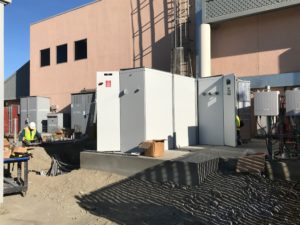Powered Emergency Response Centers (PERCs) Updates

Workers installing the inverters and batteries
EcoMotion’s first six microgrid projects are now taking shape at the Santa Rita Union School District in Salinas, California. All six school sites now feature solar systems sized to completely wipe out their PG&E bills. Batteries are being placed as we write; SRUSD will soon have impressive 7.3-hour energy storage capabilities. These are the prototype Powered Emergency Response Centers, PERCs, developed by EcoMotion. The PERCs will serve their schools and their communities during prolonged power outages.
EcoMotion began working for SRUSD in October 2015. Our charge was to tap Prop 39 monies to “harden” these campuses with battery storage. And not the two-hour garden variety of storage that dominates the California behind the meter storage market! No, the District wanted students to be able to shelter in place, to continue with their studies throughout the 7.3-hour school day. We initially recommended gen-sets for such infrequent use, but shortly thereafter became clear about the District’s resolve.
After much planning and development, a rigorous competitive solicitation, challenges with financing the package, a tricky timeline to secure PG&E’s A6 rate option, the PERCs are near complete. The solar systems are up, energy management systems have been put in place to control loads in “rainy-day scenarios,” and given the recently approved interconnection agreements, the batteries have been moved from a secure warehouse nearby, and now are being placed on the campuses. The nation’s first carbon-free PERCs are soon to become operational.
School, other institutions, and even our homes can attain energy resilience – or be “self-contained” – in a number of ways. Diesel-powered generator sets with a tank of fuel in reserve are common and relatively inexpensive, and have been a favored option given the low probability of an outage on any given day. They’ve been used for decades for “mission-critical installations.” But the Santa Rita Union School District wanted batteries, and needed to get them with no money down. Its limited Prop 39 monies were ultimately used for campus efficiency and system controls.

Solar Carport at Gavilan Middle School
One of the project’s greatest barriers was that it had never been done before. Solar PPAs are common. Power Efficiency Agreements for storage are not uncommon, based on avoiding ratcheting demand charges. But what EcoMotion recommended for SRUSD was novel… to wrap solar and long-term storage together in one PPA, held by one financier. Ultimately, Generate Capital in New York City saw the value of the PERC concept and how it address campus resilience in a new way, and provided project financing. Remarkably, the deal was done at parity, on par with the price that SRUSD currently pays for grid power, and likely less over time.
According to Kirk Stokes of Sharp Energy Solutions, the lead implementer and asset manager, first and foremost, everything is on track. Getting the interconnection agreements through PG&E clearly has been the most challenging part of the project. Sharp chalks this up to “the first-time syndrome.” SRUSD is building systems, PERCs, that haven’t been built and operated before.
The interconnection applications were filed in June of 2017. After five months of back and forth, all were accepted last week after some control system changes. The systems have been approved for both grid-tied (normal) and “islanded” operations during outages. Islanded operations will be tested in January prior to final permission to operate.
At the heart of the microgrids are three-port, DC coupled inverters. The systems are based on net energy metered solar (green power), and storage that is designated as “non-export.” Solar is used to fulfill onsite load, charge the batteries, or feed back into the grid for net energy metering credit. Storage, on the other hand, can be used to only fulfill campus needs, providing energy and frequency control in the event of grid outages. PG&E will not allow CUHSD to buy brown power at night, store it, and then to sell it at a profit during the day. And of course, that is not the District’s intent.
SRUSD intends to fill up the batteries with solar and to then use the solar on a daily basis to fulfill campus needs, keeping full batteries in reserve at each site for deployment in the event of an outage. Black and Veatch, the system engineers was required to add hardware that will open DC contacts to physically prevent back-feeding into the grid from the batteries and to assure non-export of brown electrons during outages. Stay tuned; there’s more to come!
